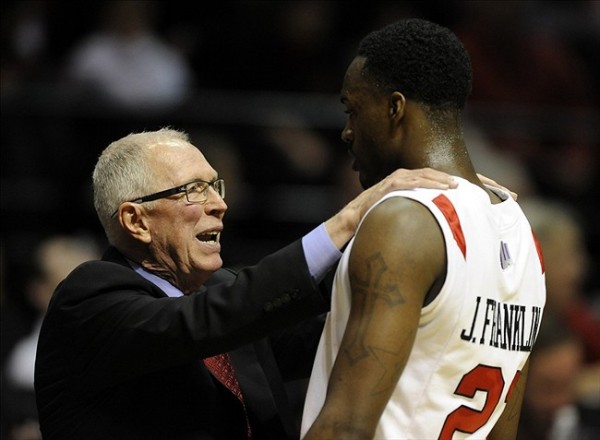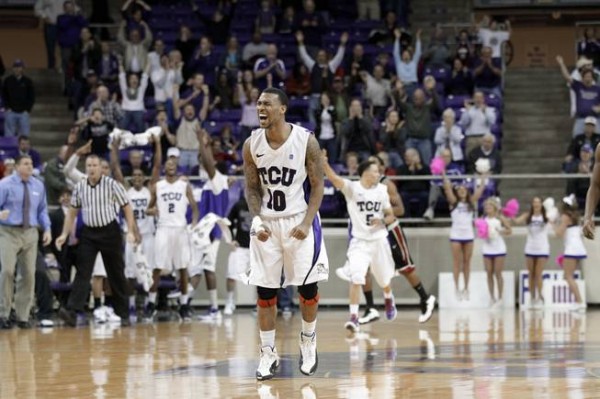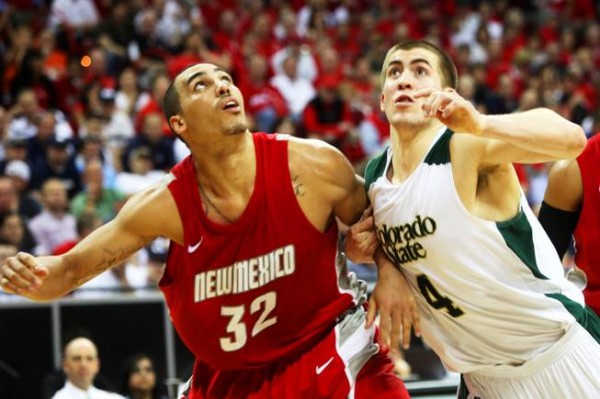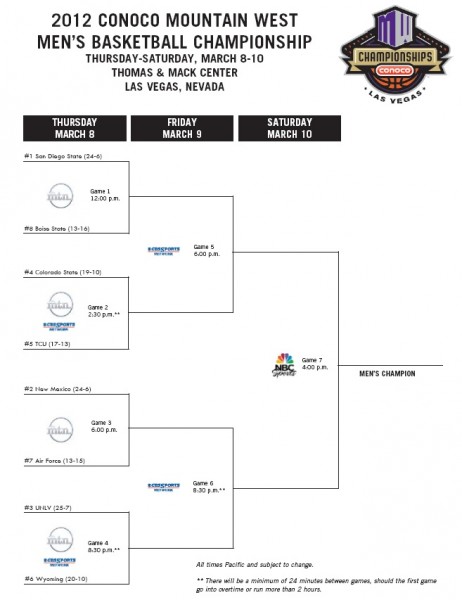Mountain West Tournament Preview & Season Wrap-Up
Posted by AMurawa on March 8th, 2012Andrew Murawa is the RTC correspondent for the Mountain West Conference.
Tournament Bracket
Coming into the year, we thought we had a couple really good teams in New Mexico and UNLV, and six other teams with more questions marks than answers. Four months later, add San Diego State to the list of really good teams, but add the other five teams in the conference as, at a minimum, pretty good. Only Air Force and Boise State end the season with losing records, and each of those teams has risen up and played one of the top three tough at some point, with the Falcons even pulling off a win over San Diego State. There are four teams (so far) with 20 or more wins and it looks more and more like Colorado State, with home wins over each of the top three teams in the conference, will join them in the NCAA Tournament. Meanwhile, Wyoming and TCU both remain strong candidates for NIT inclusion. All told, this was an excellent encore performance for a conference that was coming off their best season on the national stage, especially given the turmoil surrounding the Mountain West’s hits and misses in the conference realignment game. In short, despite a few bumps and bruises along the way, the MW is still alive and well. At least for now.
Final Standings
- San Diego State 24-6 10-4
- New Mexico 24-6 10-4
- UNLV 25-7 9-5
- Colorado State 19-10 8-6
- TCU 17-13 7-7
- Wyoming 20-10 6-8
- Air Force 13-15 3-11
- Boise State 13-16 3-11
Superlatives
Player of the Year. Drew Gordon, Senior, New Mexico. This was a tight race, with Gordon, UNLV’s Mike Moser and San Diego State’s Jamaal Franklin all neck and neck at the finish line. But, I’ll always hold true to the theory that when in doubt, a tie goes to the senior. And I’ll still gladly make the argument that Gordon edges out the other two on his own merits as well. The one thing that all three players do well is rebound the ball, but Gordon is the best of the three. Franklin is more capable of creating his own shot than Gordon, but Gordon generally plays within himself and is more efficient offensively; likewise, while Moser has a perimeter jumper that is missing from Gordon’s game, it doesn’t go far enough to make up for the other advantages that the Lobo star has. And, defensively, Gordon is significantly more polished than either of his younger competitors. The race is very close, and in no way am I denigrating either Moser or Franklin. But likewise, I don’t want to take the easy way out and just call it a three-way tie. Call Gordon the better of equals.
Coach of the Year. Steve Fisher, San Diego State. It has been a year of great coaching jobs in the Mountain West as well, but the race here is slightly less contentious. While we give Gordon the MW POY award by a nose, Fisher wins this by a full body length over guys like Jim Christian, Larry Shyatt, and Tim Miles. Christian and Shyatt took teams with basically the same personnel as last year and led a complete 180, while Miles took a team that lost three of its best players and has them a nose ahead of where they were last year. Meanwhile, Fisher took a team that lost its four leading scorers, including NBA First Round pick Kawhi Leonard, off a Sweet 16 team and led a ragtag bunch that included a undermanned frontline (Tim Shelton and his three knee surgeries, basketball novice Deshawn Stephens, and graduate transfer Garrett Green) to an unlikely Mountain West title. Along the way, he helped transform Chase Tapley from a role player into a team leader and a go-to scorer and Jamaal Franklin from a little-used reserve to a big-name player on the national scene. Oh, and then there’s the whole conference title and national top 25 ranking. That’s nice too.
Newcomer of the Year. Mike Moser, Sophomore, UNLV. All of last season and during the summer, we heard whispers about how good Mike Moser was going to be for the Rebels this year. It didn’t take long for him to prove himself in a big way. He opened the season with 16 points and 20 rebounds against Grand Canyon, followed up soon after with 23 and 17 against Morgan State, a team a step higher in competition. By the end of November, he was going for 16 and 18 against national power North Carolina in one of the defining earlier games of the year. All told, there were 14 double-doubles for the UCLA transfer and plenty of wow moments. His production tailed off some at the end of the year, but Moser has been a revelation for first year head coach Dave Rice.
Freshman of the Year. Hugh Greenwood, New Mexico. The traditional numbers for the Aussie freshman point guard aren’t going to wow anybody (6.4 PPG, 3.5 RPG, 2.5 APG), but there are plenty of tempo-free stats that go a long way towards showing just how comfortable he has been in Steve Alford’s employ since the get-go. He’s more or less split time with junior Jamal Fenton at the point, and has been just about as efficient offensively as any of the upperclassmen on the Lobos. He does a great job chipping in on the defensive glass, grabbing 15% of available defensive rebound opportunities, and he hands out assists on over 20% of his team’s field goals when he is in the game. Throw in some strong defense, a heady offensive game and some clutch play down the stretch and the future is very bright for Greenwood.
Defensive Player of the Year. Drew Gordon, Senior, New Mexico. Gordon’s work on the defensive glass alone (29.1 defensive rebound percentage – good for fourth in the nation) makes him a strong contender for this award. He was also second in the league to Wyoming’s Leonard Washington (another strong candidate for this award) in blocked shots and consistently helped A.J. Hardeman cause problems for the opposing front lines in the MW.
Most Improved Player: Jamaal Franklin, Sophomore, San Diego State. Last year, on a loaded Aztec team, Jamaal Franklin earned eight minutes a game (at least in the 22 games he played in) and averaged less than three points and less than two rebounds per game. This year, he busted out for 31 points on 10-of-17 shooting (with four threes) and, if it’s even possible, seemed to improve as the season went on. He gave a hand to an undermanned frontline by turning into an excellent rebounder (he had ten or more rebounds in ten of his final 14 games) and became SDSU’s go-to player in conference play, never once failing to score more than ten points and coming within a couple of rebounds of averaging a double-double in MW play. He’s still got room to grow (he needs to shore up his shot selection and increase his accuracy), but given the lengths he’s come in just a year, his ceiling is awful high.

Jamaal Franklin (With Our MW Coach Of The Year, Steve Fisher) Showed Vast Improvement This Season (Christopher Hanewinckel/US Presswire)
All MWC First Team
- G Jamaal Franklin, So, San Diego State (17.1 PPG, 8.6 RPG)
- G Chase Tapley, Jr, San Diego State (15.2 PPG, 4.3 RPG, 2.1 APG)
- G Dorian Green, Jr, Colorado State (13.4 PPG, 3.6 RPG, 2.6 APG)
- F Mike Moser, So, UNLV (14.0 PPG, 10.7 RPG, 2.4 APG)
- C Drew Gordon, Sr, New Mexico (13.2 PPG, 11.0 RPG)
All MWC Second Team
- G Kendall Williams, So, New Mexico (12.0 PPG, 3.3 RPG, 4.1 APG)
- G Anthony Marshall, Jr, UNLV (12.0 PPG, 5.1 RPG, 4.8 APG)
- F Pierce Hornung, Jr, Colorado State (8.4 PPG, 8.3 RPG)
- F J.R. Cadot, Sr, TCU (11.3 PPG, 7.0 RPG)
- F Leonard Washington, Jr, Wyoming (12.7 PPG, 6.8 RPG)
Honorable Mention
- G Hank Thorns, Sr, TCU (13.4 PPG, 4.6 APG)
- F Chace Stanback, Sr, UNLV (13.o PPG, 4.6 RPG)

We Couldn't Find A Spot For Hank Thorns On Our Two Conference Teams, But The Senior Deserves A Mention (AP)
Power Rankings and Tournament Preview
Before we get to the power rankings and team-by-team breakdown, just wanted to say how much I am looking forward to this Mountain West tournament. I don’t know that there is a team here capable of making a run to the Final Four (whereas last year, SDSU at least had that type of ceiling), but if all the top seeds advance to the semifinals on Friday night, we’re due for another phenomenal night of basketball in Vegas, capable of being as interesting as the semis the last two years (and that’s saying a LOT, because the last two years were phenomenal). There is a chance, however, that one or more of the top three seeds could run into some trouble. While New Mexico has beaten Air Force by an average of 34.5 points per game this year, the Falcons really aren’t that bad of a team. Boise State, meanwhile, has played San Diego State pretty tight this year, losing a heartbreaker in San Diego before dropping the game in Boise by 13. And UNLV lost at Wyoming this year before beating the Cowboys by 11 last weekend. Certainly UNM, SDSU and UNLV will be solid favorites in each of those games, but those teams at the bottom of the conference are good enough to spring an upset today.
1. New Mexico 24-6, 10-4 (Projected NCAA Seed Range: #4-8)
Season Review: It’s been a bit of a roller coaster ride this season for the Lobos, starting with two losses in the first four games of the season (to New Mexico State and Santa Clara, no less), followed later by a pair of losses to San Diego State and UNLV near the start of conference play that put them in a hole. But, when they rebounded to gain revenge on those two teams a month later, they were in the driver’s seat in the conference, with a two-game lead with four to play. Looking back now, it is hardly surprising that they then proceeded to drop road games to Colorado State and TCU (the latter in a blowout) to give back that lead. Still, given their excellence on the defensive end and an offense that is nearly the equal of anyone else in the conference, they’ve got to be considered the strongest team in the MW, and by a pretty significant margin. UNM outscored its conference opponents on a per possession basis by 0.17 PPP, while UNLV (0.08) and SDSU (0.05) had much slimmer margins.
Tournament Preview: Still, the fact that SDSU earned the #1 seed in the conference (by virtue of a better record against TCU) gives them an easier path to the final, while the Lobos face the prospects of running into a UNLV team playing on its home floor in front of a jacked-up Friday night crowd. If the Lobos somehow come out of this tournament as conference champs, they will likely have gone through both UNLV and SDSU (although, there could be plenty of upsets in this year’s tourney) and will have gone a long way towards earning a 4 seed, although a 5 in that scenario might be more likely. An unlikely opening round loss to Air Force probably knock them back to around an 8, with other scenarios (either a loss in the semis or finals) landing them somewhere in between those extremes.
2. San Diego State 24-6, 10-4 (Projected NCAA Seed Range: #4-8)
Season Review: I’ll give the Aztecs the nod over the Rebels at this point, simply because they are playing better right now. UNLV’s season numbers are better, but they’ve hit some turbulence of late. Meanwhile, the Aztecs rebounded nicely from a three-game losing streak in February to reel off four straight to end the season, even though they needed a couple overtimes to get those. But, Jamaal Franklin finished strong, although his partner-in-crime, Chase Tapley definitely tailed off at the end of the year, hitting just 16 out of his 52 field goal attempts (for an eFG% of 34.6) in those final four games. Steve Fisher needs him to regain his early-to-mid season form for SDSU to have a successful March. The Aztecs just don’t have a whole lot going for them offensively if Tapley isn’t able to be a scorer for them.
Tournament Preview: The Aztecs earned themselves a good draw, not having to deal with either UNLV or New Mexico untiltthe finals, but they shouldn’t look past Boise State in the opener. The Broncos gave the Aztecs all they could handle on Montezuma Mesa at the start of February, and when Boise’s prodigious amount of three-point attempts are falling, they could be dangerous to anyone. But, the Aztecs should advance out of there and then have a very winnable semifinal game against either Colorado State or TCU. And, given the Aztecs’ recent history in this event (they’ve won it the last two), they’ve got to be considered a serious challenge. And, much like the Lobos, if they come out of this weekend with a tourney title, they could inch as high as a 4 seed, although, again, a 5 is more likely. A first-round loss to Boise could drop them back as far as an 8, with a 7 being the more likely landing spot in that scenario.
3. UNLV 25-7, 9-5 (Projected NCAA Seed Range: #4-7)
Season Review: Much like the last two seasons, the Runnin’ Rebels came out of the gate strong, ripping off eight in a row to start the year (including their season-defining win over North Carolina) and 21 of their first 24. Since then, however, they are 4-4, with the wins coming at home and the losses on the road. And while their offensive numbers have been pretty similar in all eight of those games (albeit, similarly average – 1.02 PPP in the wins, 0.98 PPP in the losses), the defense has been wildly divergent (allowing an excellent 0.87 PPP in the wins and a terrible 1.11 PPP in the losses). Put simply, the Rebels are built, first and foremost, on defense. Sure, some of the difference in those numbers on the road are attributable to Hank Thorns going absolutely nuts in the second half at TCU, but allowing Wyoming – a pretty average offensive team – 1.08 PPP, for instance, isn’t going to get it done either. And, more to the point, part of the reason those offensive numbers are so average is that the UNLV defense serves as a sparkplug for the offense; if they’re not defending well, their offense suffers as well. The Rebels have a weekend here in order to get their mojo back before heading to the NCAAs, but if that doesn’t happen, this team is a toothless lion next week.
Tournament Preview: The good news for the Rebels is that they’re playing what are, ostensibly, home games: home court, home town, and plenty of Rebel fans in the building to provide a pick-me-up when their energy flags. And they’ll need all of that in what should be a knock-down, drag-out, brawl in their opening round game against Wyoming. The Cowboys will ugly things up and try to grind one out, so the Rebs need to stay poised and aggressive. If they advance to the semis, things don’t get any easier, with New Mexico likely to be waiting for them in what could be an epic semifinal matchup. Much like the teams above, a tourney win could kick the Rebs as high as a 4 seed on Sunday, a more realistic seed for them than either SDSU or UNM,given their resume-boosting win over UNC and lack of bad losses. And, unlike the other two teams, their floor is pretty low. A loss to Wyoming would not be ideal, but I don’t think it would kill the Rebels as much as opening round losses would hurt SDSU or UNM; the Rebs probably don’t fall below a 7 seed.
4. Colorado State 19-10, 8-6 (Projected NCAA Seed Range: #10-12)
Season Review: It’s pretty simple for the Rams – great team at home, bad team on the road. It took until the final game of the conference schedule for CSU to win on the road (against Air Force, a team that finished tied for last place). But, they didn’t lose a home game in conference (and their only loss at home all season was to Southern Miss back before Thanksgiving). The Rams are a drastically undersized team (they’ve got a trio of “big” guys generously listed at 6’6” that play along the frontline), but they shoot it lights out, they get to the free throw line and, once there, they drill their freebies.
Tournament Preview: Last year Colorado State came into this tournament needing to at least get to the championship game to have any chance of earning an NCAA bid. That didn’t happen. This year, they’ve got a bit more leeway, in that advancing to the championship game would almost certainly earn them a bid. And, they even have a good chance to earn an invitation (barring a run of bid thievery over the next few days) even with a semifinal loss to SDSU. An opening round loss to TCU, however? I wouldn’t chance it, Rams.

Pierce Hornung (right) Is One Of Colorado State's Undersized But Effective Frontcourt Players (Justin M. Bowen/Las Vegas Sun)
5. Wyoming 20-10, 6-8 (Projected: NIT)
Season Review: Last season, the Cowboys came into the conference tournament with their overall record reversed: 10-20. That says just about all you need to know about the job Larry Shyatt has done with this team. How has he done it? A new emphasis on defense (the team was ranked 191st in defensive efficiency last year, they’re 24th this season) is the primary reason. They’ve increased the number of turnovers they force, they’ve gone from a very bad defensive rebounding ream to one of the best in the country, and they’ve given up completely on grabbing offensive rebounds in favor of getting back early to play defense. On offense, they’ve also tightened up the ship, cutting down on turnovers, running some semblance of an offense and, as a result, getting a lot better shots and making a higher percentage of them. Great year for the Cowboys.
Tournament Preview: Unfortunately for the Cowboys, and every team from here on down, it is without a doubt a matter of either winning the MW Tournament this week or being left out of the big bracket on Sunday. However, even if the Cowboys flame out in the first round against UNLV, they should still be assured of an invitation to the NIT, with a chance to earn a home game with an opening round win.
6. TCU 17-13, 7-7 (Projected: NIT)
Season Review: The Horned Frogs’ turn-around this season was perhaps not as pronounced as the Cowboys’, but it was a turn-around nonetheless. Last year they lost 18 of their final 20 games and finished 11-22. This year, they’ve got wins over Virginia, UNLV, New Mexico and Colorado State – all likely NCAA Tournament teams. Better yet, head coach Jim Christian has had his team improving as the year has gone on. Offensively, they’re the third most efficient team in the conference, getting the job done by hitting threes and limiting turnovers. Unfortunately, they’re still a pretty bad defensive team, only once since February 1 keeping teams under a point per possession (oddly enough, against New Mexico a couple weekends ago). Still the trio of Hank Thorns, Amric Fields and J.R. Cadot has been largely excellent this year, with a handful of other players turning in solid performances on a regular basis.
Tournament Preview: While it is win it all or consider other options for the Frogs, they’re in a good position to give their fans a treat with an opening round win over Colorado State today. And, despite an RPI of 100, that win, plus the good wins already in their pocket, could earn them an NIT bid. Otherwise, it may be off to the CBI for this team, provided they’re interested.
7. Air Force 13-15, 3-11
Season Review: The big news this year was the mid-season firing of head coach Jeff Reynolds, and then the announcement this week that his replacement, Dave Pilipovich, had been promoted from interim head coach to just plain old “head coach.” The Falcons have shown some improvement since the coaching change was made, winning two of their first three games under Pilipovich before slipping back and dropping their last four. For next year, Pilipovich returns much of the team, including leading scorer Michael Lyons and a handful of talented youngsters (Kamryn Williams, Justin Hammonds, Max Yon) that could lead to a bump up the standings for the Academy.
Tournament Preview: An opening round win over New Mexico would at least send the team and their fans into the offseason with a sense of accomplishment – that’s really all they’re playing for at this point. And, they’re capable of pulling off that upset, regardless of previous results. The odds of them stringing together several upsets to make a run? Negligible, at best.
8. Boise State 13-16, 3-11
Season Review: Boise’s temporary stopover in the Mountain West did not exactly get off to a great start. After beginning the season 8-1, the Broncos proceeded to lose 15 of their next 20 games, with an eight-game losing streak mixed in there and a four-game losing streak (still ongoing) to end the season. Injuries are partly to blame, as is youth, but head coach Leon Rice is still in the middle of a rebuilding job, after losing his top four scorers last year. The good news? It appears freshmen Derrick Marks, Anthony Drmic and Igor Hadziomerovic are keepers, with guys like Kenny Bruckner, Drew Wiley and Jeff Elorriaga providing some additional offensive punch. Additional bad news? This team rarely showed any defensive toughness this year and will need to find some sort of leader on that end of the court in order to improve significantly next season.
Tournament Preview: Maybe then can give SDSU a fight again in their opener, but more likely, the Broncos’ season ends today.













































Great Article AM! I would say the Mountain West had a hell of a year (potentially) getting four bids.
This should be one of the most exiting championship tournaments this year.
>>>—Fear the Spear—>>>
GO AZTECS!